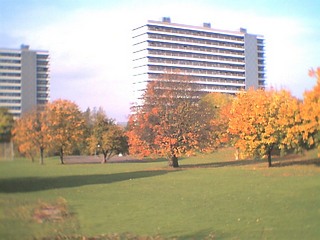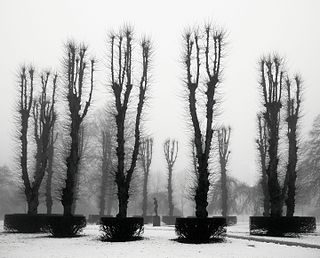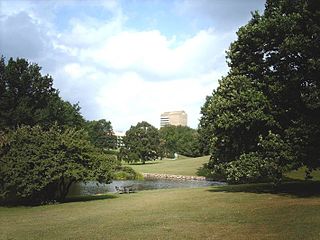 W
WThis is a list of publicly accessible parks in Aarhus. Some are managed by Aarhus Municipality, some are private, and others are managed by institutions such as hospitals and universities.
 W
WAarhus Botanical Gardens is a botanical garden in Aarhus, Denmark. It is located north of the Old Town open-air village museum and was founded in 1875. Nowadays it covers an area of 21.5 hectares, with 5 hectares for the Old Town.
 W
WAarhus Forestry Botanical Garden is a forestry botanical garden located in the south of Aarhus, Denmark. It forms a small part of the northern section of Marselisborg Forests and is situated right next to Marselisborg Palace and Mindeparken. The botanical garden was established in 1923.
 W
WÅkrogen is an urban, public beach and park in the northern parts of Aarhus, Denmark.
 W
WÅparken is a public park in central Aarhus, Denmark. The park is situated by the Aarhus River in the Vesterbro neighborhood in Midtbyen close to CeresByen, bounded by the streets Carls Blochs Gade and Thorvaldsensgade. The park is divided by a central pedestrian pathway which runs from the urban center and connects to the recreational path Brabrandstien towards the west, circumventing Brabrand Lake area. Åparken is the first of a number of green areas extending from the city centre along the river and the pathway of Brabrandstien. The long distance "Aarhus-Silkeborg hiking route" starts off from Åparken.
 W
WBallehage Beach is an urban, public beach in the southern parts of Aarhus, Denmark and from 1929 it is one of the oldest sea baths in Denmark. Ballehage Beach is situated in the Marselisborg Forests on the Bay of Aarhus in the suburb of Højbjerg, south of Marselisborg Yacht Harbour and the Aarhus River mouth. Helgenæs lies across the bay to the east, a bit inland to the west is the Marselisborg Deer Park and to the north is the Varna Palace. The beach area is some 1,000 metres long and between 10 and 30 metres wide. It is a white sandy beach with occasional rows of boulders extending into the sea, for coastal erosion protection. Ballehage Beach is popular for sunbathing and swimming due to the shielding effect and scenic view of the nearby forest on the steep hillsides to the west. The beach has a single jetty extending some 20 metres into the sea, offering a platform to jump from or relax on. There are outdoor changing facilities, toilets and storage areas. The Beach is open year-round for everyone at no charge.
 W
WThe Concert Hall Park is a public park in central Aarhus, Denmark. The park is laid out in front of the Aarhus Concert Hall main entrances in the Indre By neighborhood of the inner city. It is bordered by the street Frederiks Allé to the east, Thomas Jensen's Allé to the south and Vester Allé to the north, behind the historic buildings of the former Vester Allés Barracks. The park is named after the Aarhus Concert Hall which is situated prominently immediately west of the park. The Concert Hall Park forms a center-point between some of the most prominent buildings in the city, the ARoS Aarhus Art Museum, Vester Allé Barracks, the concert halls, and Aarhus City Hall in view behind the City Hall Park across Frederiks Allé. The Concert Hall Park was designed by the landscape architect Sven Hansen as a parterre garden, and it was established in the 1980s.
 W
WLangenæs Park is a public park in the Langenæs neighborhood in the Aarhus C district in Aarhus, Denmark. The park is situated west of the Frederiksbjerg neighborhood along the curved street Langenæs Allé to the south and the AArhus rail yard to the north. Langenæs Park is one of the largest parks in Aarhus and is composed of mainly landscaped lawns with trees scattered throughout along with a large section dedicated to sports. Facilities include soccer fields, a disc gold field, picnic areas and a paved running track. Langenæs Park was established in connection with the development of the Langenæs neighborhood in the 1970s and is today the primary recreational spot in the area along with Frederiksbjerg Bypark to the west and the Rehabilitation PArk to the south. The park is owned by Aarhus Municipality and is managed by the municipal department Natur og Miljø and can be rented for public events.
 W
WMarienlyst Park is a public park in Hasle in the Aarhus V district, north-west Aarhus, Denmark. The park is situated west of the Herredsvang neighborhood along the street Fjældevænget Busvej to the south and Brendstrup Forest to the west. Marienlyst Park is one of the largest parks in Aarhus and features both landscaped lawns and artificial forested hills. Facilities include an amphitheatre, soccer fields, playgrounds and a 6-hole golf course. Marienlyst Park was established in connection with the development of western Hasle in the 1970s and today forms part of a green corridor extending from Vestereng to Brabrand Lake. The park is owned by Aarhus Municipality and is managed by the municipal department Natur og Miljø. Marienlyst Park can be rented for public events.
 W
WMarselisborg Deer Park is a 22 hectares enclosed woodland area in the northern parts of the Marselisborg Forests. The trees are somewhat sparse here and the terrain especially hilly, compared to the surrounding forest.
 W
WMindeparken is a memorial park and recreational area in the south of Aarhus City, next to Marselisborg Palace.
 W
WMølleparken is a park in the city of Aarhus located in Midtbyen. Mølleparken was constructed in 1926 where the, by then obsolete, mills of the city had been situated by the river since 1289. Today the park lies by the Aarhus River and the ARoS Art Museum and functions as a section of a pedestrian arterial from ARoS to the Latin Quarter.
 W
WNordre Cemetery is a cemetery in Aarhus, Denmark. It was established in 1876, east of Aarhus University and Aarhus University Hospital by Nørrebrogade.
 W
WRådhusparken is a public park in central Aarhus, Denmark. The park is situated by the City Hall in the Indre By neighborhood of Midtbyen, between the streets Frederiks Allé to the west and Park Allé to the east. The park lies within a scenic semi-circle of some of the more important cultural and political institutions in the city; the Concert Hall, the ARoS Art Museum, Vester Allés Kaserne and the city hall. The City Hall Park was listed along with the adjacent city hall on 10 March 1995.
 W
WRiis Skov is a forest and park in Århus, Denmark. It is located south of the district of Risskov, along the Bay of Aarhus.
 W
WSkæring Hede or Skæring Mindelund is a forest and memorial park in Skæring, the northernmost suburb of Aarhus, Denmark. Skæring Hede was originally a large heath but today only a fraction of it remains as encroaching suburbs and areas with summer houses have gradually taken over much of the natural land in the area, through the 70s and 80s. The remaining area of 8.5 hectares are mainly forest, although some heath do remain, and is managed as a public forest park by Aarhus Municipality. Today Skæring Hede is one of only a few public forests in Skæring and the northernmost park in Aarhus. The forest is mainly mixed pine and birch forest with a number of walking paths crossing through it and it is home to a World War II memorial. Skæring Hede is well known as the place where five Danish resistance fighters were executed during the Second World War in one of the first mass executions during the war. Parking facilities on Åstrup Strandvej.
 W
WSkanseparken is one of the oldest parks in the city of Aarhus. It is situated in the neighborhood of Frederiksbjerg in Midtbyen. Skanseparken was constructed in the years 1901 to 1902 between the streets Strandvejen, Marselisborg Allé and Heibergsgade. The park is typical of the parks in the city with large, open areas bounded by beech trees, raised flower beds and playgrounds. It is a popular area for festivals, concerts and other cultural events.
 W
WSt. Oluf Cemetery is a small public park and historic site in central Aarhus, Denmark. The park is situated by the coast in the city center of Midtbyen, in the Latin Quarter, bounded by the streets of Kystvejen and St. Olufs Stræde, overlooking the Docklands and the Bay of Aarhus in the East. It is one of only two green spaces in the historic inner city, the other one being Frue Kirkeplads at the Church of Our Lady, but is one of five protected scheduled monuments.
 W
WTangkrogen is a public park in Aarhus, Denmark. The park is situated in the neighborhood Midtbyen by the coast with the Bay of Aarhus to the southeast, the Marselisborg neighborhood to the West and the Port of Aarhus to the North. The park is bounded by Strandvejen and Marselis Havnevej across from Chr. Filtenborgs Square. It is a municipal park managed by the Nature and Environment department of Aarhus Municipality. Tangkrogen got its name from the kelp that filled the cove when recreational jetties were constructed when the city of Aarhus initially developed the area into a public park in the early 20th century.
 W
WAarhus University Park or the University Park is a public park in central Aarhus, Denmark. The University Park is at the centre of Aarhus University's main campus.
 W
WVennelystparken is the oldest park in the city of Aarhus, constructed in the years 1824 to 1830 between the streets Vennelyst Boulevard and Nørrebrogade. Through the 19th century up to the Second World War the park was a social focal point in Aarhus hosting revues, circusses, plays and concerts in changing venues. The park is now part of the Aarhus University campus in Midtbyen. The park no longer has any venues but is frequently used for open-air concerts and protests and functions as the local park of the neighborhood Øgadekvarteret.
 W
WVestre Kirkegård, established in 1927, is one of two large municipal cemeteries in Aarhus, Denmark with Nordre Kirkegård being the other. The cemetery was inaugurated in 1927 when Nordre Kirkegård was filled up. Originally, the cemetery was 5 hectares, but it has been expanded several times, until its present size of 16.9 hectares.